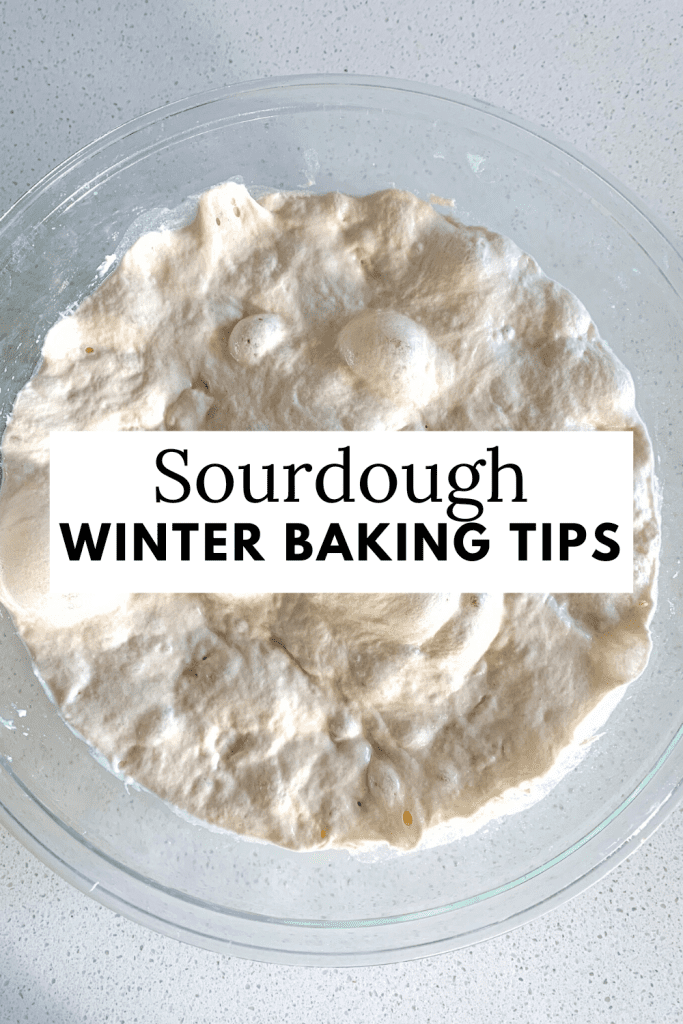Sourdough Winter Baking Tips
I’m sharing all of my sourdough winter baking tips to help you learn the best practices for using your starter during the cold months. From starter care to getting your dough to double during the bulk ferment, I’m sharing it all.

This post may contain affiliate links of items I know and love. Read our disclosure policy for more information.
If you want to make this recipe but don’t have a sourdough starter, no worries! Grab my free guide so you can make your own starter at home.
If you’re new to sourdough baking and feel hesitant, or you have questions, I’ve got something for you! I broke down the basics of what you need to know about sourdough baking in my free sourdough baking guide for beginners. I highly recommend grabbing a copy!
Reasons Winter Baking with Sourdough Can Be Difficult
When it comes to baking with sourdough in the winter, the main issues are a result of cooler temperatures. When a sourdough starter or any kind of sourdough dough is too cold, it takes a very long time to double in size. That’s why your breads and baked goods turn out dense, flat, and weird.
Not to mention, sometimes with the dryer weather, your starter and baked goods might need more liquid. This means adding in a few tablespoons extra when needed due to dryer conditions.
Common Issues When Baking with Sourdough During Cold Months
- Inactive Starter: Not enough wild yeast present, not feeding it correctly before using it
- Sluggish Starter: Too cold and slow fermentation
- Dough Isn’t Doubling: Too cold and slow fermentation
- Starter and Dough is Dry: Cool temps sometimes make dough and starters more dry so they need extra liquid.
Tips to Care for Your Starter During Winter
During winter, it is crucial to have a strong sourdough starter. This means you need to:
- Make sure you’re using unbleached flour and filtered water so you’re not killing off any of the sourdough cultures.
- Feed it a minimum of once a week, letting it sit on the counter until it doubles in size before placing it back in the fridge. This ensures the cultures are growing and can multiple quickly before slowing down in the fridge.
- This feeding should be a 2:1 ratio of flour to water.
- Feed your starter 4-12 hours BEFORE you use it for any recipe calling for a fed starter. It must be active and bubbly before you begin to ensure a light, fluffy baked good.
Tips for Bulk Fermenting and Rising Dough During Winter
When bulk fermenting and rising dough in the winter, you’ll need to place it in a warm place for 12 hours or until the dough has doubled. You can do this in a few ways:
- Slightly warm the oven to about 75-80 degrees Fahrenheit, then turn it off and place your dough inside with the door shut. Never leave the oven on, not even with the keep warm setting when your dough is inside. It’ll get too hot.
- In a turned-off oven with the light on and the oven door slightly cracked open.
- In a dough proofing box set to 75-80 degrees.
- On a warming mat set to 75-80 degrees.
Winter Sourdough Bread Baking Tips
Make sure your starter is active!
Before you get started with this recipe, you need to feed your starter a 2:1 ratio of flour to water 4–12 hours before you start. Your sourdough starter needs to be very active and bubbly to begin.
Let the dough bulk ferment for 12 hours.
It is important to let your dough bulk ferment for the full 12 hours. It should double in size and have air bubbles in it. If It’s really cold you’ll need to go even longer if the dough isn’t doubled.
Place the dough in a warm spot to rise.
For both the bulk ferment and the second rise after shaping, your dough needs to be at room temperature in a non-drafty place. If your dough doesn’t look like it’s doing anything halfway through the rises, you need to place it in a slightly warmer area.
This can be in a turned-off oven with the light on and oven door open, or you can slightly warm the oven to about 75-80 degrees Fahrenheit, then turn it off and place your dough inside with the door shut. Never leave the oven on, even on the keep warm setting, with fermenting dough inside. Your dough, for both rises, needs to double.
Answering Your Winter Baking Questions
You’ll want to place the dough in a warm place, like a turned-off oven with the light on and the door cracked. If your oven doesn’t have a light, you can warm the oven to 75-80 degrees (or just warm to the touch but not hot).
Really anything below 68 degrees Fahrenheit is going to be too cold. At this point, you’ll need to place the starter and/or dough in a warm place, like I shared in the question above.
It’s colder than it was in summer, so the fermentation process is slowed down. Just like when you place your starter or dough in the fridge.
You’ll notice your starter will be a little slow to get hungry during the cold months. I recommend feeding it the same as you usually do, about once a week when stored in the fridge or once a day if stored at room temperature. Unless you’re using fed starter multiple times throughout the week, then you’ll want to feed it before each recipe.
If your dough isn’t rising even in a warm oven, that indicates your levain (sourdough starter) is weak and needs to be strengthened. When you place a weak starter or unfed starter in the dough of a baked item that needs to rise, it won’t double in size, even if it’s in a warm atmosphere.


